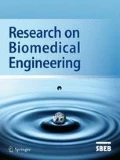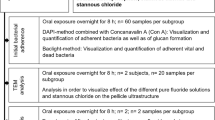Abstract
Purpose
This study aimed to analyze the fluoride concentrations in different dentifrices with antimicrobial and natural molecules marketed in Brazil. Thus, 12 dentifrices were selected to be analyzed for the concentration of total fluoride (TF), total soluble fluoride (TSF) and ionizable fluoride (IF).
Methods
Two tubes of each brand were purchased at different locations. The samples were analyzed in duplicates using an ion-specific electrode and the concentrations were determined in μg F/g.
Results
The TF of all calcium carbonate dentifrices showed averages below 1500 ppm F. Regarding TSF, only one toothpaste had an average above 1000 ppm F−, while the IF values were almost 500 ppm F. In the analysis of fluoride in dentifrices which present silica as abrasive, the TF presented averages below 1500 ppm F, while the TSF all presented averages close to 1000 ppm F−, and the IF values varied from close to 500 ppm to more than 1000 ppm F. In dentifrices whose formulation contained calcium carbonate associated with silica or other formulations such as sodium bicarbonate, the TF, TSF, and IF values were all above 1000 ppm F.
Conclusion
The evaluated dentifrices generally showed TF concentrations lower than those declared on the packaging; however, the TSF content remained close to 1000 ppm F. It can be concluded that the analyzed dentifrices with antimicrobial molecules showed values close to those suggested regarding anti-caries effect.



Similar content being viewed by others
Change history
08 February 2021
A Correction to this paper has been published: https://doi.org/10.1007/s42600-020-00109-0
References
Benzian H, Holmgren C, Buijs M, van Loveren C, van der Weijden F, van Palenstein Helderman W. Total and free available fluoride in toothpastes in Brunei, Cambodia, Laos, the Netherlands and Suriname. Int Dent J. 2012. https://doi.org/10.1111/j.1875-595X.2012.00116.x.
Brasil, ministério da saúde, agência nacional de vigilância sanitária. Portaria n° 729, de 28 de agosto de 2000. Diário Oficial União. 30 ago 2000;1415–1537.
Carrera CA, Giacaman RA, Muñoz-Sandoval C, Cury JA. Total and soluble fluoride content in commercial dentifrices in Chile. Acta Odontol Scand. 2012. https://doi.org/10.3109/00016357.2011.640287
Conde NC de O, Rebelo MAB, Cury JA. Evaluation of the fluoride stability of dentifrices sold in Manaus, AM, Brazil. Pesqui Odontológica Bras. 2003. https://doi.org/10.1590/S1517-74912003000300009
Cury JA, Tenuta LMA. Evidence-based recommendation on toothpaste use. Braz Oral Res. 2014. https://doi.org/10.1590/S1806-83242014.50000001.
Cury JA, de Oliveira MJL, Martins CC, Tenuta LMA, Paiva SM. Available fluoride in toothpastes used by Brazilian children. Braz Dent J. 2010. https://doi.org/10.1590/S0103-64402010000500003.
Cury JA, Caldarelli PG, Tenuta LMA. Necessity to review the Brazilian regulation about fluoride toothpastes. Rev Saude Publica. 2015. https://doi.org/10.1590/S0034-8910.2015049005768
Farha FP, Nobre-dos-santos M, Rodrigues LKA, Vidigal EA. Avaliação da disponibilidade de flúor em dentifrícios infantis encontrados no comércio brasileiro. UFES Rev Odontol. 2006;8(3):25–30.
Furtado Júnior JH d C, Valadas LAR, Fonseca SG d C, Lobo PLD, Calixto LHM, Lima AGF, et al. Clinical and Microbiological Evaluation of Brazilian Red Propolis Containing-Dentifrice in Orthodontic Patients: A Randomized Clinical Trial. Evidence-Based Complement Altern Med. 2020. https://doi.org/10.1155/2020/8532701.
Giacaman R. Sugar and dental caries: new insights of an old problem and its implication in clinical management. J Oral Res. 2016;5:57–8. https://doi.org/10.17126/joralres.2016.011.
Hashizume LN, Lima YB d O, Kawaguchi Y, Cury JA. Fluoride availability and stability of Japanese dentifrices. J Oral Sci. 2003;45:193–9. https://doi.org/10.2334/josnusd.45.193.
Lobo PLD, Fonteles CSR, de Carvalho CBM. do Nascimento DF, da Cruz Fonseca SG, Jamacaru FVF, et al. Dose–response evaluation of a novel essential oil against Mutans streptococci in vivo. Phytomedicine. 2011;18(7):551–6.
Lobo PLD, Fonteles CSR, Marques LARV, Jamacaru FVF, Fonseca SG d C, de Carvalho CBM, et al. The efficacy of three formulations of Lippia sidoides Cham. essential oil in the reduction of salivary Streptococcus mutans in children with caries: a randomized, double-blind, controlled study. Phytomedicine. 2014 Jul;21(8–9):1043–7.
Pitts NB, Zero DT, Marsh PD, Ekstrand K, Weintraub JA, Ramos-Gomez F, et al. Dental caries. Nat Rev Dis Prim. 2017;3(1):17030.
Ricomini Filho AP, Tenuta LMA, Fernandes FS d F, Calvo AFB, Kusano SC, Cury JA. Fluoride concentration in the top-selling Brazilian toothpastes purchased at different regions. Braz Dent J. 2012;23(1):45–8.
Thakkar VP, Rao A, Rajesh G, Shenoy R, Pai M. Fluoride content and labelling of toothpastes marketed in India. Community Dent Health. 2015 Sep;32(3):170–3.
Vorster L, Naidoo S, Stauf N, Holmgren C, Benzian H. Fluoride content of toothpastes available in South Africa. Community Dent Health. 2018;35(3):186–92.
Walsh T, Worthington HV, Glenny A-M, Appelbe P, Marinho VC, Shi X. Fluoride toothpastes of different concentrations for preventing dental caries in children and adolescents. Cochrane Database Syst Rev. 2010;(1):CD007868. https://doi.org/10.1002/14651858.CD007868.pub2
Acknowledgments
The authors acknowledge Brazil University.
Author information
Authors and Affiliations
Corresponding author
Ethics declarations
Conflict of interest
The authors declare that they have no conflicts of interest.
Additional information
Publisher’s note
Springer Nature remains neutral with regard to jurisdictional claims in published maps and institutional affiliations.
The original online version of this article was revised: Table 1: In line D2 it should read Colgate Tripla ação, in D5 it should read Even Juá and in D8 it should read Sorriso Dentes brancos. The heading of Table 2 should read “Comparisons between fluoride concentrations in different toothpastes according to measurement modality (mean difference ± SD) “. The second line should have no numbers and should read: CaCO3: ns *** ****.
Rights and permissions
About this article
Cite this article
Medeiros, M.d.d., Valadas, L.A.R., Lotif, M.A.L. et al. Evaluation of fluoride concentration in toothpastes with antimicrobial molecules commercialized in Brazil. Res. Biomed. Eng. 37, 9–14 (2021). https://doi.org/10.1007/s42600-020-00094-4
Received:
Accepted:
Published:
Issue Date:
DOI: https://doi.org/10.1007/s42600-020-00094-4




